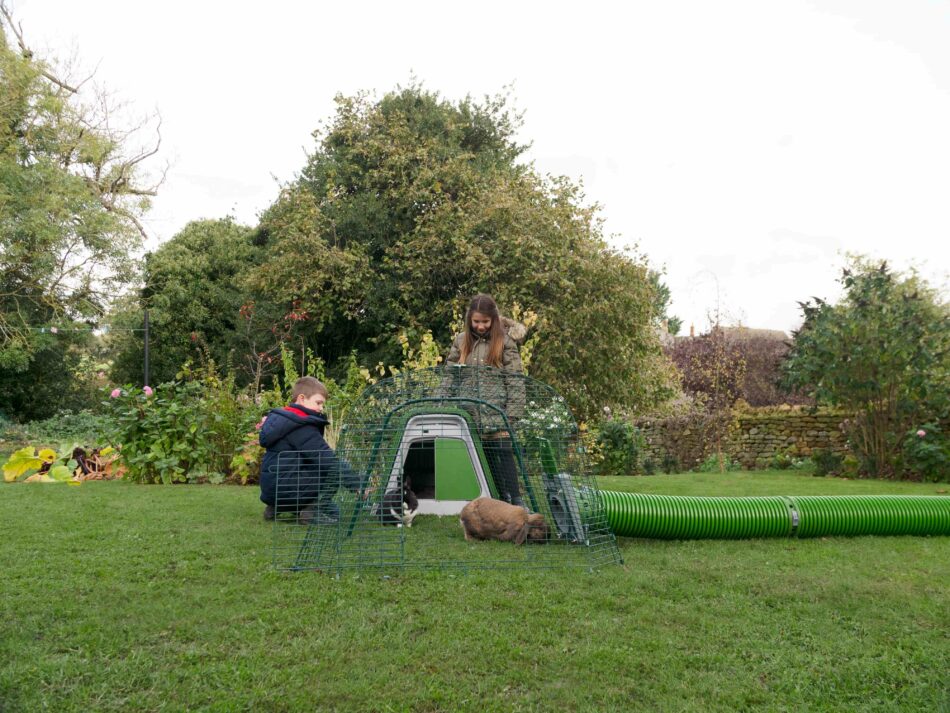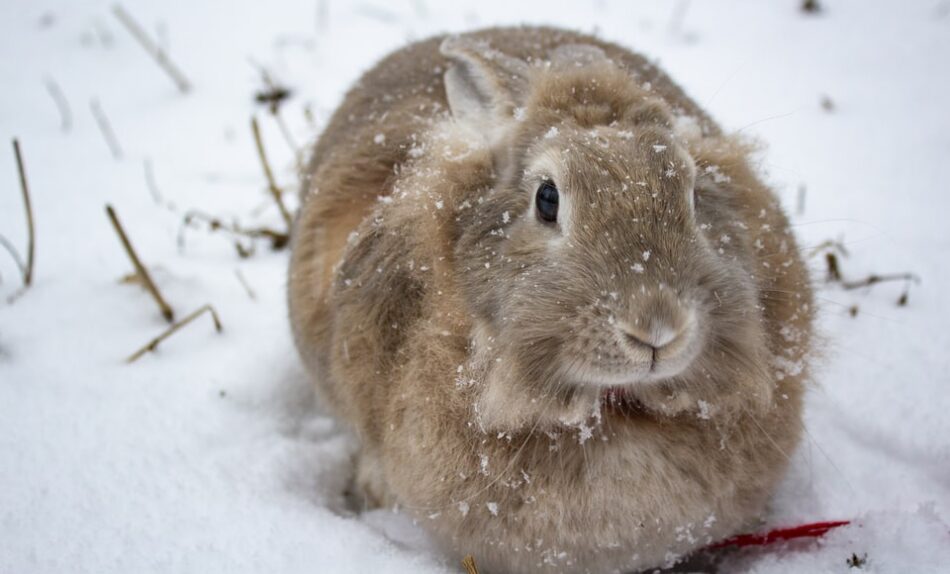Will my rabbits be okay outside in the winter?
 We often get questions about whether rabbits will be okay outside in the winter. The simple answer is: yes. But things get a little more complicated when you consider the specific climate, individual rabbits, and their setups. We’ll share how you can safely keep your outdoor rabbits outside during the winter, and how to determine if and when it’s time to bring them inside.
We often get questions about whether rabbits will be okay outside in the winter. The simple answer is: yes. But things get a little more complicated when you consider the specific climate, individual rabbits, and their setups. We’ll share how you can safely keep your outdoor rabbits outside during the winter, and how to determine if and when it’s time to bring them inside.
Can rabbits live outside during the winter months?
Rabbits that are accustomed to living outdoors are well-equipped to handle the winter months. At this point in the year, you’ve probably noticed your outdoor rabbits’ fur looking mottled due to a process called moulting. Moulting in rabbits is a natural process that prepares their coats for the winter months ahead, and is triggered by the amount of daylight. So, if your rabbit is outdoors during summer and fall, the dwindling daylight hours signal them to start shedding their thinner summer coat in order to regrow a more dense coat for the winter.
Once they’ve donned their winter coats, your rabbits can withstand the colder outdoor temperatures quite well. In fact, rabbits are much more comfortable in the cold than they are in the heat. But, in order for their natural insulating layers to be effective, bunnies need dry, clean areas to shelter in.
In the wild, rabbits will warm up in underground warrens, or burrows, and huddle together for warmth. Domesticated rabbits need a similar environment – a draft-free, dry hutch to warm up in. The Eglu Go Rabbit Hutch was designed with this in mind. The twin-insulated walls offer protection from drafts while containing the natural body heat of your rabbits within. And, our hutch is designed to provide ample ventilation to prevent moisture buildup, which is especially important during the winter months.
But will they be happier inside?
It may be tempting to bring your outdoor rabbits inside for the winter, but the trouble with this is threefold:
- Bringing your bunnies inside for more than brief visits acclimates them to your home’s interior temperature. This makes it more difficult to move them back outside without shocking their system.
- The artificial lighting in your home will disrupt their biological clock, which may cause them to shed their winter coat too early.
- They will need indoor accommodations away from the hustle and bustle of your home activities. Rabbits may become stressed by stimuli such as televisions, radios, children playing, or other loud noises – especially around the holidays.
Rabbits that are well adjusted to their conditions and schedules outside will thrive much better staying in their home all year round – including during the winter. If your rabbits have lived outside for the rest of the year, save for a couple of caveats.
How cold is too cold for rabbits?
Rabbits don’t adhere to a particular rule when it comes to temperatures. What is true for most bunnies might not apply to others. Observe your bunnies as well as the weather in order to gauge how cold is too cold for your rabbits. If temperatures have been gradually declining over several weeks, your rabbits’ coats should be sufficient to keep them warm enough in even sub-zero temperatures. But, here is where the first caveat of bringing your bunnies inside comes in:
- If the temperatures have been mild for weeks, and your area experiences a sudden and brief cold snap, you may want to consider bringing your rabbit indoors.
This is because a rapid and temporary drop in temperature can be too much for a rabbit that hasn’t finished growing its winter coat. However, the addition of extreme temperature protection on your rabbits’ hutch is enough to bolster your bunnies through a quick cold spell. You can also move your rabbits to a sunnier area of your garden, or under the shelter of a garage or shed in the event of freezing precipitation.
The other caveat to leaving your bunnies outdoors is their health:
- Older rabbits, or those with health conditions that may affect their coats or metabolisms should spend seasons with extreme temperatures indoors.
They don’t have to miss out on all the fun though. Rabbit runs and playpens can be utilised both indoors and outdoors to create safe spaces. On mild winter days, your rabbits will appreciate a romp outside in the sunshine.
What can I do to help my rabbits in winter?
This advice applies if you keep rabbits in an outdoor rabbit hutch and run. If you’re moving your pets inside you won’t have to worry too much about protecting them from bad weather.
Regularly checking in on your rabbits is one of the best ways to ensure they’re in good health, and give you an idea of how well they’re handling the weather. But, there are some other ways you can help your rabbits through the winter.
Exercise
Exercise helps ramp up your rabbits’ metabolisms to help keep them warm during the winter. Make sure they have plenty of space and opportunity to stretch their legs and generate heat. Connecting their hutch to a Zippi Rabbit Playpen via our Zippi Rabbit Tunnel System gives them plenty of room to burrow, explore, and play.
Location
Keep your rabbits’ hutch in a place that receives as much sun during the day. Use clear rabbit run covers during the winter months to allow warming rays of sunshine in for your rabbits to stretch out. If your area receives a lot of snowfall, the addition of wheels and handles to your rabbit hutch allows for quick and easy movement to shelter or shovelled areas.
Bedding
You’ll find your rabbits spending more time in their hutch during the winter due to both decreased daylight hours and temperatures. Make sure to change their bedding frequently to keep them clean and dry. Choose a thick bedding like straw and provide a thick layer for your bunnies to burrow into.
Diet
Your rabbits should have unlimited access to timothy hay all year round, as well as a serving of quality pellets daily. To stoke their metabolisms during the winter, gradually add in alfalfa hay or pellets into their diet to provide extra energy. Other treats like leafy greens can be served in a Caddi Rabbit Treat Holder to keep it up off of the frozen ground.
You’ll also want to switch to a crock or bowl for their water during the winter months to prevent bottles from breaking in freezing temperatures. A bird bath heater or plug-in heated pet water bowl can be used to keep their water thawed – just be sure that the cords are not within your rabbits’ nibbling range.
Your outdoor rabbits with Omlet
Don’t stress over your rabbits during the colder weather. With our Eglu Go Rabbit Hutch, Zippi Rabbit Runs and Playpens, and Zippi Tunnel System, you can create a winter wonderland that both you and your rabbits can enjoy. With dry, insulated dwellings, your bunnies will boldly take on the chilly temperatures – and you will rest assured knowing they’re comfortable and happy not just during this season, but all year round.

This entry was posted in Rabbits